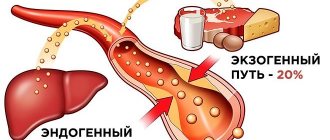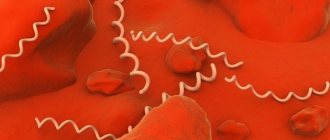Cholesterol is an organic compound found in cell membranes. Necessary for cell construction, synthesis of sex hormones, bile acids, and nutrient metabolism. It plays an important role in the human body, but sometimes causes significant harm.
There are two types of cholesterol in the blood: “good” (HDL) and “bad” (LDL). An increase in the concentration of the latter becomes the main cause of the formation of plaques in blood vessels, resulting in an increased risk of stroke and heart attack. High cholesterol levels are dangerous to health, so they need to be reduced. The most effective methods will be discussed in the article.
What is cholesterol
This is a type of lipid present in the structure of human and animal cells. 20% of it comes from food, and the bulk is synthesized by the body itself. At normal concentrations, this substance is not harmful, but even necessary, because it:
- strengthens cell membranes;
- promotes digestion;
- participates in the formation of sex hormones;
- stimulates the production of vitamin D;
- protects nerve fibers;
- reduces cell permeability.
Cholesterol is present in the body at any age. It is required for survival and cannot be replaced by anything. However, we often hear this substance mentioned in a negative context. This is a misconception, since only one type of it causes harm. It is important to distinguish them.
Cholesterol: main functions
Cholesterol is a substance without which normal metabolic processes in the body are impossible. In other words, it is vital, because without it:
- Certain hormones and vitamin D will not be produced;
- normal production of bile acids is impossible;
- renewal and construction of cell membranes is impossible.
That is, it is impossible to talk about the absolute harm of cholesterol for the body. This is the same as talking, for example, about the dangers of oxygen.
Good and bad cholesterol
In everyday life, good is called high-density lipoprotein, and bad is low-density lipoprotein. Lipoprotein is cholesterol in a protein shell made of apolipoprotein.
High density means that there is little cholesterol in the compound itself: the bulk is protein. In this ratio, lipid transport is facilitated. It enters the liver and is excreted with bile, without settling anywhere. That's why he is considered good.
Low-density lipoprotein, on the other hand, is predominantly composed of cholesterol. Its removal from the body is difficult. This is the type that is considered bad. It lingers in vascular cells and causes atherosclerosis. In addition, it tends to accumulate with age. An adult has much more of it than a child.
Blood cholesterol levels in men and women by age
Over the years, indicators that can be considered normal change. The meanings are not the same for men and women. Here is a table that will help you avoid getting confused and keep your health under control.
| Age | Norm of total cholesterol (mmol/l) | |||
| Women | Men | |||
| Minimum | Maximum | Minimum | Maximum | |
| 20-30 years | 3,16 | 5,75 | 3,16 | 6,32 |
| 30-40 years | 3,37 | 6,27 | 3,57 | 6,99 |
| 40-50 years | 3,81 | 6,86 | 3,91 | 7,15 |
| 50-60 years | 4,20 | 7,77 | 4,09 | 7,15 |
| 60-70 years | 4,45 | 7,85 | 4,12 | 7,10 |
| 71 years and older | 4,48 | 7,25 | 3,73 | 6,86 |
A common myth is that you need to start tracking your cholesterol levels closer to retirement age. This is a big misconception. Doctors recommend donating blood for the first time at the age of 25. The unhealthy lifestyle of modern youth contributes to a more active accumulation of low-density lipoproteins, which is why heart disease increases in age.
Risk group for atherosclerosis
Atherosclerosis
- an insidious disease that develops gradually. Cholesterol level is an indirect indicator of the risk of developing atherosclerosis, but some categories of people need to be tested for cholesterol at certain intervals. The following recommendations are given:
- men over 40 years old;
- women over 45 years old;
- people with diagnosed diabetes;
- overweight people;
- people with diseases of the thyroid gland, kidneys and high blood pressure;
- smokers;
- people who lead a sedentary lifestyle.
It is important to understand that at the first stage of development, atherosclerosis has no visible specific manifestations. A person may not even be aware of the developing disease and the problem with cholesterol. Therefore, doctors recommend regularly donating blood for biochemical analysis.
Why is lipid metabolism disrupted in the body?
Lipid metabolism is a complex metabolic process. An important part is cholesterol metabolism. Its disorders are one of the main causes of cardiovascular diseases.
The disorder can occur for various reasons:
- heredity (in this case, the first symptoms appear in childhood);
- diseases of the gastrointestinal tract;
- endocrine pathologies;
- lack or excess of enzymes;
- kidney dysfunction;
- taking hormonal medications;
- bad habits;
- increased body mass index;
- physical inactivity.
For an adult, lipid metabolism disorders do not go unnoticed. Men experience hair loss prematurely, and women experience disruptions to their menstrual cycle. Excess cholesterol affects the condition of the skin and general well-being.
Symptoms of high cholesterol in the body
An excess of this substance has external signs. White circles form around the iris of the eye. The skin turns yellow and lipid deposits (xanthomas) appear on it. Usually these are small tubercles, but there are xanthomas in the form of papules.
The remaining symptoms do not specifically indicate increased cholesterol. The patient experiences:
- pain in the legs when walking;
- feeling of chest compression;
- heartache;
- digestive disorders.
All these troubles suggest that it’s time to see a doctor. It is difficult to understand from the symptoms that it is time to take an LDL test. As a result, lipid metabolism disorders go unnoticed for a long time, sometimes until the vessel becomes blocked. Because of this, cholesterol is called the silent killer.
How to prepare for a lipid profile
Anyone can take a lipid profile, but you should prepare for this procedure in advance, otherwise the indicators may be inaccurate. If you are planning to take this test, then ideally you should not drink alcohol for three days or at least a day before going to the clinic.
The night before, refrain from having a heavy dinner with fried, fatty or sweet foods. Try to eat early - no later than 20:00. In the morning - no coffee, tea, mineral water, juice or other sweet drinks - you can only drink plain water.
If you are taking any medications or biologically active substances, check with your doctor whether you can take them before the test, or they may distort the data.
What to do to normalize cholesterol
Today it is not uncommon for the results of a blood test for total cholesterol to deviate from normal. At the same time, there may be a lack of good things in the body, while the level of bad things is increased. Accordingly, the value of low-density lipoproteins should be reduced, and high-density lipoproteins should be increased.
Let's start with the last one. Intense physical activity is enough for this. Clearing the body of LDL is more difficult. It requires:
If high cholesterol is caused by an endocrine or other disease, it will be difficult to lower it without proper treatment. Therefore, before taking measures, it is worthwhile to undergo a comprehensive examination, in particular, donate blood for hormones.
When should you start monitoring your cholesterol?
It's never too early for prevention. It’s better to get used to monitoring your health from a young age, then it will present you with fewer unpleasant surprises. It is especially important to pay attention to your health after 40 years of age
, this is true for both men and women. In men, coronary heart disease may begin to develop earlier than in women. This is explained by hormonal levels. Women of childbearing age have more “good” cholesterol in their bodies, while in men the preponderance may lean toward “bad” cholesterol. After menopause, women's bad cholesterol levels may also begin to rise along with their triglyceride levels.
If previously it was believed that atherosclerosis mainly affects mature and elderly people, now the disease is diagnosed in younger patients, so it would be reasonable to start controlling cholesterol levels at 30-35 years of age. If the analysis shows that everything is normal, a re-check can be carried out after 3-4 years, but if the cholesterol level is elevated or there is a genetic predisposition to the development of heart and vascular diseases, then it is worth checking the cholesterol level more often.
Do children suffer from high cholesterol?
Cholesterol levels in children, as a rule, do not rise above normal, but they can also be at risk if hereditary hypercholesterolemia is found in their family. In this case, the child will be registered with a pediatric cardiologist from an early age. A cholesterol test should be done at the age of two years, and then repeated periodically.
Diet and lifestyle of people with high cholesterol
An adult understands that a normal cholesterol level is the key to vascular health. Atherosclerosis impedes blood flow, forcing the heart to work harder to pump blood through the narrowed arteries. Sooner or later the plaques will block the vessel, and the person will have a heart attack.
To avoid this outcome, it is important to achieve normal LDL levels. To do this, it is important to adjust your lifestyle, and first of all, your eating habits:
- reduce consumption of trans fats;
- increase your intake of monounsaturated fats;
- increase consumption of polyunsaturated fats;
- give up instant coffee and drink only natural coffee in limited quantities.
We must not forget that the level of cholesterol in the blood changes over the years. Therefore, you need to review your diet periodically (at least once every five years). And it is better to do this under the supervision of a doctor.
How to treat high cholesterol
To reduce LDL levels, it is important to address the cause of high cholesterol and any predisposing factors. First, you should do a lipid profile. The examination shows how serious the increase is . High cholesterol is treated by a general practitioner or cardiologist. There is also a more specialized specialist - a lipidologist.
To reduce high cholesterol levels in the body, you must adhere to the following recommendations:
- Follow a diet. Namely, reduce the consumption of animal fats, “fast” carbohydrates, and foods with trans fats. Nutritional correction reduces LDL levels by 10-15%.
- To refuse from bad habits. Moreover, not only active smoking, but also passive smoking is detrimental to health.
- To live an active lifestyle. It is useful to walk in the fresh air and set aside time for physical exercise. Exercise for at least 30-60 minutes. in a day.
- Control your weight. Fat deposits in the abdominal area are especially dangerous.
- Control blood sugar levels. This recommendation applies to patients with diabetes, as well as people who are predisposed to this disease.
- Cure endocrine diseases, normalize hormonal levels.
Sometimes statins are needed to treat high cholesterol. They produce an immediate effect, but scientists are increasingly talking about their shortcomings. Drugs in this group do not have a selective effect, they reduce everything - both “bad” and “good” cholesterol, and also negatively affect the functioning of the liver. However, their harm is less than the complications of critically high LDL levels.
What you can’t eat and what you can
The difficulty in following the diet is that banned trans fats are found in foods that many are accustomed to. The patient will have to completely give up sweets and starchy foods and reduce the consumption of fatty foods to a minimum. Nutritionists are trying to find healthy alternatives to unhealthy foods.
| It is forbidden | Can |
| Cakes | Oat cookies |
| Pork | Chicken |
| Fried foods | Stews |
| Butter | Vegetable oil |
| Sour cream | Low-fat yogurt |
| By-products (liver, lungs) | Fish |
| Semolina | Oatmeal |
| Marmalade | Natural jelly |
Eggs are a controversial product. Yolks help increase cholesterol, while proteins, on the contrary, are useful for its breakdown. The recommended solution is to divide the egg into parts and eat only the whites.
Ways to Maintain Normal Cholesterol Levels
High levels are recorded in a biochemical blood test. If the numbers regularly exceed the norm, it is important to undergo a medical examination of the thyroid, pancreas, liver, and take a hormonal profile test. To normalize fat metabolism, courses of antilipid drugs are prescribed.
A therapeutic diet low in meat and dairy products also helps lower total cholesterol. It is useful to include sea fish containing Omega-3 complex, olive, flaxseed, sunflower oils, fresh vegetables, and herbs in your food.
Drugs that lower total cholesterol
This group of medications is called stanina. This is one of the types of lipid-lowering drugs used to eliminate lipid metabolism disorders.
Statins are used when the level of low-density lipoprotein is so high that it is impossible to reduce it with lifestyle changes. You cannot take them without permission, since the wrong dosage will affect the functioning of the liver. It is better for an adult to make an appointment with a cardiologist.
Vitamins also help indirectly with high cholesterol. The main role here is given to representatives of group B. B3 is involved in fat metabolism, B6 promotes the absorption of fatty acids, B8 accelerates lipid metabolism. Vitamins A and E prevent the formation of cholesterol plaques.
THERE ARE CONTRAINDICATIONS, BEFORE USE YOU MUST CONSULT WITH A SPECIALIST










